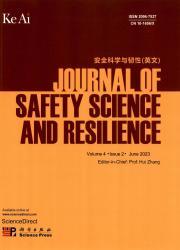Systematic literature review of Ergonomic evaluation methods in the mining sector (2015-2024)
IF 3.4
Q1 PUBLIC, ENVIRONMENTAL & OCCUPATIONAL HEALTH
引用次数: 0
Abstract
Musculoskeletal disorders (MSDs) in the mining sector are frequently associated with exposure to ergonomic risk factors, leading to decreased productivity and increased absenteeism. This study presents a systematic literature review of ergonomic evaluation methods, identified risk factors, and affected body regions, based on journal articles indexed in ScienceDirect, Emerald, Taylor & Francis, Wiley, Scopus, Sage, IEEE Xplore, and Web of Science. From an initial pool of 213 studies, 49 primary studies were selected, 82 % of which were published in Q1 or Q2 journals. The review identifies six individual ergonomic assessment methods (Nordic Questionnaire, ISO/IEC 2631–1, REBA, OWAS, NIOSH, and Risk Score) and two hybrid methods (Bayesian Network + REBA, and RULA + Nordic Questionnaire). Additionally, it categorizes 13 affected body parts (e.g., back, shoulders, neck, waist) and 11 ergonomic factors (e.g., heavy loads, repetitive tasks, vibration, static postures, and work schedules). The findings reveal that a majority of studies focus on underground mining operations, with the Nordic Questionnaire and ISO/IEC 2631–1 being the most frequently used methods. The back and shoulders are the most commonly studied body parts, while vibration and working hours emerge as the most prevalent risk factors. Finally, six challenges are proposed to address current research gaps, including the integration of deep learning techniques and the evaluation of less-studied joints such as the wrist and elbow. This review provides a valuable foundation for researchers and mine safety professionals seeking to advance ergonomic assessment in mining environments.
采矿业人机工程学评价方法系统文献综述(2015-2024)
采矿部门的肌肉骨骼疾病(MSDs)往往与接触人体工程学风险因素有关,导致生产力下降和缺勤率增加。本研究对人体工程学评估方法、确定的危险因素和受影响的身体部位进行了系统的文献综述,基于ScienceDirect、Emerald、Taylor &;Francis, Wiley, Scopus, Sage, IEEE explore, and Web of Science。从最初的213项研究中,选择了49项主要研究,其中82%发表在Q1或Q2期刊上。该综述确定了六种单独的人体工程学评估方法(北欧问卷、ISO/IEC 2631-1、REBA、OWAS、NIOSH和风险评分)和两种混合方法(贝叶斯网络+ REBA和RULA +北欧问卷)。此外,它还对13个受影响的身体部位(如背部、肩部、颈部、腰部)和11个人体工程学因素(如重负荷、重复任务、振动、静态姿势和工作时间表)进行了分类。调查结果显示,大多数研究集中于地下采矿作业,北欧调查表和ISO/IEC 2631-1是最常用的方法。背部和肩部是最常被研究的身体部位,而振动和工作时间是最普遍的危险因素。最后,提出了解决当前研究空白的六个挑战,包括深度学习技术的集成和对腕部和肘部等较少研究的关节的评估。这一综述为研究人员和矿山安全专业人员寻求在矿山环境中推进人体工程学评估提供了有价值的基础。
本文章由计算机程序翻译,如有差异,请以英文原文为准。
求助全文
约1分钟内获得全文
求助全文
来源期刊

安全科学与韧性(英文)
Management Science and Operations Research, Safety, Risk, Reliability and Quality, Safety Research
CiteScore
8.70
自引率
0.00%
发文量
0
审稿时长
72 days
 求助内容:
求助内容: 应助结果提醒方式:
应助结果提醒方式:


